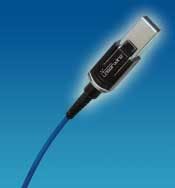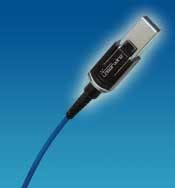by Stephen Hardy
Almost out of nowhere, a market appears to be developing for active optical cables as an alternative to copper links in high-performance computing and data center environments. Not surprisingly, several vendors have rushed to develop products to meet this hot spot, spurred both by demands for 10-Gbit/sec links as well as the promise of 40- and 100-Gbit/sec interconnect requirements in the future.
The initial sweet spot for active optical cabling is high-performance computing, including cluster computing�applications that have begun to spread from the R&D and scientific communities to high-end enterprise applications for modeling, simulation, and computer-aided design. Passive and active copper cabling provides much of the InfiniBand-based server-to-server and server-to-switch connections in such environments. However, as connectivity requirements reach or exceed 10 Gbits/sec and users wish to connect a greater number of more distant computers into clusters, copper�s usual bandwidth/distance limitations have become more acute. Industry sources report that passive copper connections begin to sag at around 10 m at 10 Gbits/sec, for example.
Recognizing this, the InfiniBand community has developed optical specifications for 10-Gbit/sec (single data rate, or SDR), 20-Gbit/sec (dual data rate, DDR), and 40-Gbit/sec (quad data rate, QDR) InfiniBand connections. Each specification calls for multichannel transmission, using anywhere from four to 12 channels.
The specifications lend themselves well to the use of parallel optical arrays, packaged in a quad small-form-factor pluggable (QSFP) transceiver. While a number of vendors have developed such optical transceivers for next-generation platforms, the devices didn�t help users who faced the challenge of linking fielded systems designed with copper ports.
Active optical cables enable such legacy boxes to enjoy the benefits of optical transmission. As their name implies, the cables come with optical transceivers mounted on each end that provide electro-optical conversion and optical transmission. Users can simply remove the pluggable copper-based transmission device (usually either a CX-4 or QSFP) and plug in the active cable�s transceiver/connector, whose form factor mirrors that of the copper device it replaces. To the line card, the active optical cable end looks and acts just like a copper-based transmission device.
The fact that the fiber cable comes �hard wired� to the transceiver removes some of the obstacles fiber has encountered in data centers and similar applications. Technicians don�t have to worry about eye safety, cleaning, splicing, and other connectorization issues, for example. �It�s more like taking all the advantages you�ve ever thought of fiber for and taking all the disadvantages away,� according to Dennis Hess, director, business development, in the Fiber Optics Business Unit of Tyco Electronics (www.tycoelectronics.com).
But it turns out that pushing 10 Gbits/sec and above over distances between 100 and 300 m (depending upon the product under discussion) represents only the beginning when it comes to the new cable�s advantages. For example, CX-4 copper InfiniBand interconnects have served as many optical cable suppliers� primary initial target. These interconnects, based on 24 AWG copper cables, are heavy, bulky, and space eating. Intel (www.intel.com), the first active optical cable supplier to target this niche when it introduced its Intel Connects Cables in June of last year, cites several physical advantages its DDR assemblies provide. These include 84% less weight occupying 83% less volume than their copper counterparts. In addition, the optical transceiver is shorter than the standard CX-4 interface; combined with the natural flexibility of the thinner optical cable, the Connects Cable�s design offers a bend radius 40% less than 24 AWG copper links, Intel says.
Add lower latency, indifference to electromagnetic interference, relief from unintended ground loops, and a price equal to and often better than active copper cables (links that provide amplification and equalization that extend the reach of copper-based transmissions), and active optical cables have plenty of attributes that users should find appealing. In fact, Hess, whose company launched the PARALIGHT line of active optical cables early this year (they feature a 3-mm-diameter round cable design that provides even more flexibility than the ribbon cables common to competitive offerings), reports that at least one major customer who had originally turned up its nose at the new offering has now shown serious interest, drawn by some of these �secondary� characteristics. �Some of the first applications are very short applications, several meters, where they certainly could use copper,� Hess reports. �And the only reason that they want to use fiber is because of the cable size.�
Zarlink Semiconductor (www.zarlink.com) is the third primary supplier of active optical cabling for InfiniBand CX-4 interfaces. Its ZL60615 ZLynx SDR/DDR cabling is in volume production, and Zarlink reports it has shipped more than 10,000 units since the product became generally available in the fourth quarter of last year. Mauricio Peres, director of strategy and product management for Zarlink�s Opto Communications Group, called the market potential for offerings such as the ZLynx �mind boggling� during a discussion at OFC/NFOEC this past February.
The speed with which the market has adopted active optical cables certainly has boggled Tyco Electronics somewhat, given the fact that the company has had success supplying the types of copper interconnects the new offerings are designed to replace. �Since we�re a copper company and a fiber company, we have to try to protect our copper,� Hess admits. �At the same time, I think there�s going to be a fairly rapid movement to fiber�faster than we would necessarily want that to happen.� Hess reports that Tyco Electronics is working on a message for the market that would suggest when to use copper and when to turn to fiber.
While Intel, Tyco Electronics, and Zarlink dominate the CX-4 replacement market, newer companies have targeted higher-density QSFP applications as a point of entry. Luxtera (www.luxtera.com) has created the Blazar, a QDR-capable interconnect that can support 300-m reach. The company says its silicon photonics approach enables 40-Gbit/sec operation at a 20-Gbit/sec price point, as well as low power consumption (2.2 W per end of a 4�10-Gbit/sec QDR link). Luxtera further differentiates itself by using singlemode fiber, rather than the more expensive multimode fiber other suppliers employ. (Luxtera�s design uses a single optical power source split across four channels, rather than the array of 850-nm VCSELs common to other cables.) The Blazar began sampling late last year.
Meanwhile, newcomer Reflex Photonics (www.reflexphotonics.com) introduced its InterBOARD QSFP cables last month. Scheduled to begin sampling in the second quarter of this year, the cables also offer 40-Gbit/sec performance over 300 m, although with multimode fiber.Of course, just because cables can support 40 Gbits/sec doesn�t mean that they�ll be used for such high data rates. At OFC/NFOEC, Peres noted that QDR switch chips hadn�t reached the market yet, although he expects Mellanox (www.mellanox.com) to offer this feature in its next generation of InfiniBand ICs. He said that Zarlink has its eye on the space; the company has announced that it is sampling QSFP-enabled ZLynx cables with a goal of reaching volume production this year. Hess says that Tyco Electronics has shipped some QSFP-based cables, and Intel can be expected to follow suit.
The vendors of these multichannel offerings note that their cabling can also be used in Ethernet applications, XAUI being a multichannel interface. However, given the fact that the overwhelming majority of Ethernet applications are serial, Finisar (www.finisar.com) decided that a serial active optical cable offering made sense. Its LaserWire cable, announced last year and still in development, is expected to be the first serial Ethernet offering to reach the market when it becomes available in the second half of this year.
Jan Meise, director of strategic marketing at Finisar, believes that active optical cabling makes more sense in a serial 10-Gigabit Ethernet application than a multichannel InfiniBand link. �At 2.5 Gbits/sec [per channel], the copper cable can still go 12 m, 13 m, 15 m. So for cluster types of applications or for the application where you go from the server to the first-level aggregation switch, the 12-m reach is still okay,� he explains.
When speeds reach 10 Gbits/sec per lane, optical technology really starts to shine, Meise says�and Finisar decided to focus on single-channel applications with its first offering. Meise sees applications for single-channel 10-Gigabit Ethernet in emerging server-to-switch applications. �You now see that there is development from companies like Fujitsu, Woven Systems, Force10, Arastra, which have just at the last Supercomputing show in Reno actually shown new equipment with very high-port-count 10-Gigabit Ethernet switches,� he points out.
Meise sees LaserWire having all of the advantages in the Ethernet space versus copper-based approaches that the InfiniBand offerings enjoy. He also believes that switch and NIC vendors could embrace active optical cabling as a way to decouple interfaces from transmission media. They could design their boards with copper-friendly interfaces and enable their customers to use either copper connections or active optical cable as their applications require.
However, Finisar also sees a future for active optical cabling in LAN-on-motherboard applications. For this reason, the company has decided to go with a proprietary connector design that is much smaller than common optical interfaces, including the SFP. While Finisar hopes that some switch and NIC developers will adopt the interface directly for server and switch board designs, it also plans to offer SFP+ and XFP adapters to suit more conventional applications.
But Finisar isn�t the only company with serial Ethernet aspirations. Startup Lightwire (www.lightwire.com) will use its silicon photonics expertise to offer a serial 10-Gigabit Ethernet active optical cable with an SFP+ interface by the end of this year, says company CEO Vijay Albuquerque. �We view the SFP+ as the opportunity,� he explains. �This is the space where you get the high-density switches. You take very little space on the NIC cards, on the adapter cards. And we view this as the space where the industry will consolidate.�
Albuquerque says the company will target Fibre Channel as well as Ethernet. Lightwire also has a QSFP device on its roadmap for 40-Gigabit Ethernet applications, Albuquerque added. �What we bring to that solution is extremely low power. Budget for a four-channel, 10-gigabit product over temperature is 600 mW,� he says.
�The speeds now justify optics, performance justifies optics. The question is whether you can get optical performance at prices that are very competitive,� Albuquerque concluded, perhaps speaking for his competitors as well. �I think this is the right timing. Ten-gigabit and multiples of 10-gigabit are really the right timing for active cable solutions.�

